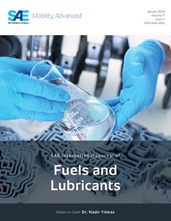Rheological and tribological properties of a model lubricant consisting of a two-component liquid crystal, mixtures of Sudan Black B (dye) and 4-cyano-4′hexylbiphenyl (6CB, liquid crystal), nano-films confined between mica surfaces were studied as functions of the surface separation distance (D) and the normal load (N). The compositions of Sudan Black B/6CB binary system were determined by FECO spectroscopy. The rheological properties which reflects the structuring and packing of binary system were examined employing the resonance shear measurement with varying the separation distance at the nanometer resolution. FECO spectroscopy revealed that apparent extinction coefficient κ of Sudan Black B/6CB increased monotonically with decreasing D, especially below ca. 6 nm, at all initial dye concentrations studied, 0.06-1.03 wt%. This indicated the increase in the Sudan Black B concentration in the gap between mica surfaces with the decreasing D, due to the interaction of a large planar structure dye, Sudan Black B, with mica surface. The resonance shear measurement revealed the sudden drop of the amplitude during the shear, which was not observed for one component 6CB. This drop corresponded to the stick-slip transition, which reflected the structural change in the confined dye/liquid crystal from the solid-like to liquid-like state. The combination of FECO spectroscopy and resonance shear measurement can give insights into the properties of multi-component mixtures depending on their composition.
